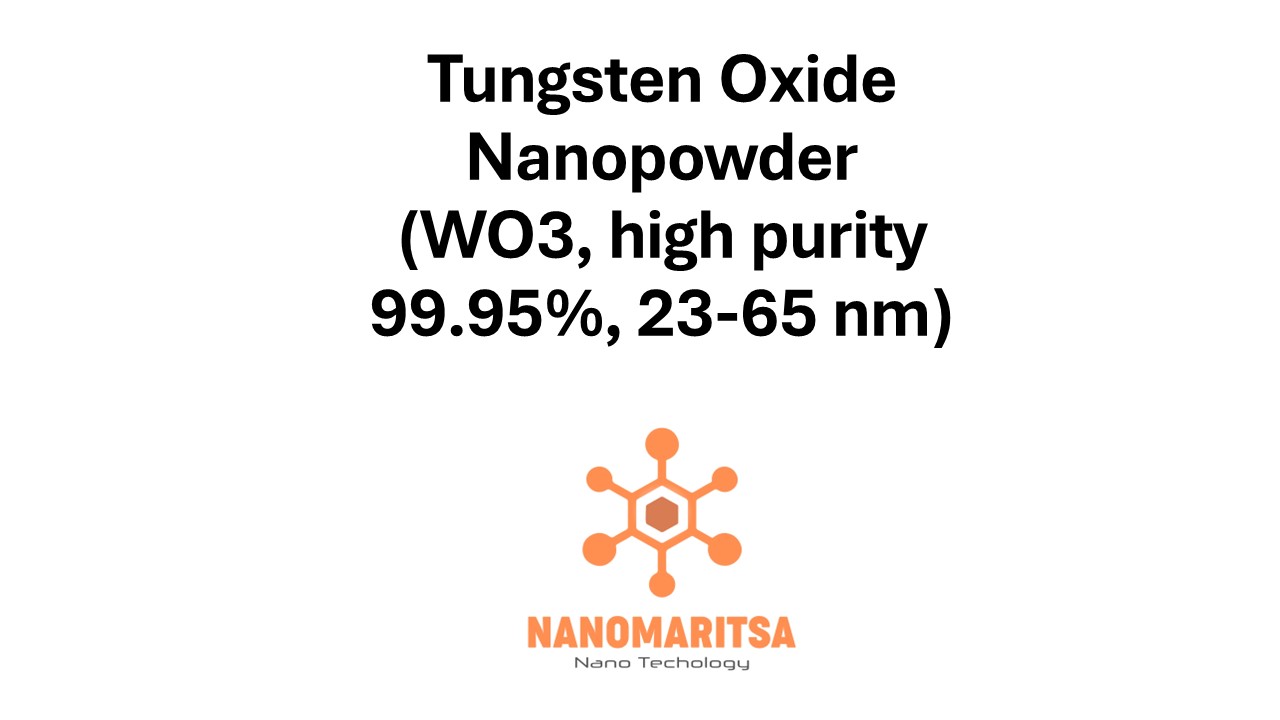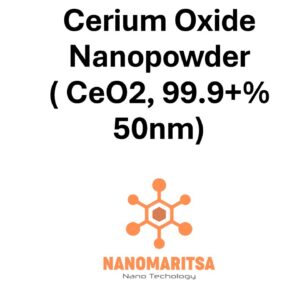Tungsten Oxide Nanopowder (WO3, high purity, 99.95%, 23-65 nm)
€480.00
CompareTungsten oxide nanopowder (WO₃, high purity, 99.95%, 23-65 nm) is a highly refined material known for its distinctive chemical, optical, and electronic properties. This nanopowder, with an exceptionally high purity of 99.95%, is utilized in a variety of advanced applications, particularly in energy, electronics, environmental management, and materials science. Its nanoparticle size of 23-65 nm allows for unique interactions at the atomic level, enhancing its efficiency and performance in various technological fields.
Composition and Structure
WO₃ (Tungsten Oxide):
Tungsten oxide is a well-known compound consisting of tungsten and oxygen. It is typically found in several phases, with the most stable and widely used phase being the tetragonal form. The presence of tungsten in the oxidation state of +6 gives WO₃ its characteristic properties, including its ability to participate in various redox reactions.
Purity (99.95%):
The high purity of 99.95% ensures that the nanopowder has minimal contamination from other elements, contributing to consistent and predictable material behavior. This high level of purity is crucial for applications that require precise material performance and longevity.
Particle Size (23-65 nm):
The nanopowder’s particle size of 23-65 nm is particularly advantageous for applications that require high surface area and reactivity. This size range allows for greater interaction with surrounding materials, leading to enhanced catalytic activity, optical properties, and conductivity.
Properties
- Optical Properties:
WO₃ exhibits strong absorption in the ultraviolet and visible regions of the light spectrum. The material’s optical properties make it highly effective for applications such as UV protection and photocatalysis. Its ability to modulate light transmission, especially in the electrochromic state, makes it an excellent choice for smart windows and light control technologies. - Electrochromic Behavior:
Tungsten oxide is widely used in electrochromic devices due to its ability to change color when subjected to an applied voltage. This electrochromic property is employed in smart window applications, where the material’s transparency can be dynamically adjusted to control light and heat entering a space, thereby improving energy efficiency. - Catalytic Activity:
WO₃, especially in its nanoparticle form, demonstrates enhanced catalytic activity compared to its bulk counterpart. The high surface area of the 23-65 nm particles makes it highly effective for catalytic processes such as the oxidation of harmful gases (NOx) in catalytic converters and in the degradation of pollutants in air and water. - Electrical Conductivity:
As a semiconductor, WO₃ exhibits varying electrical conductivity depending on the presence of oxygen vacancies and other defects. The nanoparticles’ high surface area and the ability to modify their conductivity through doping or external stimuli make them ideal for applications in sensors, energy storage devices, and optoelectronics. - Thermal Stability:
WO₃ is thermally stable, maintaining its properties even at elevated temperatures. This stability is particularly important for applications in high-temperature environments, such as in automotive exhaust systems, and in energy generation technologies.
Applications
1. Environmental and Energy Applications:
Catalytic Converters:
WO₃ is commonly used in catalytic converters to reduce harmful emissions from industrial processes and vehicles. Its ability to catalyze the oxidation of nitrogen oxides (NOx) and other pollutants makes it an essential component in environmental protection.
Hydrogen Production and Photocatalysis:
WO₃ is used in photocatalytic applications, such as water splitting for hydrogen production. By utilizing sunlight, the material can generate clean hydrogen energy, contributing to renewable energy efforts.
Energy Storage and Supercapacitors:
In energy storage systems, WO₃ is employed in supercapacitors and batteries, where its high conductivity and stability contribute to improved performance in energy storage and release cycles.
2. Electronics and Optoelectronics:
Smart Windows and Displays:
The electrochromic properties of WO₃ make it a key material in smart window technology, where it is used to regulate the amount of light passing through windows by altering its transparency. This capability allows for energy savings by reducing heating and cooling requirements in buildings.
Sensors:
WO₃ is used in gas sensors to detect the presence of various gases such as CO, NOx, and hydrogen. Its ability to change its electrical resistance in response to environmental conditions allows it to serve as a reliable sensor material in industrial safety and environmental monitoring.
3. Coatings and Surface Treatments:
Protective Coatings:
WO₃ is used as a protective coating in high-temperature applications. It is employed in coatings for automotive parts, aerospace components, and other high-performance materials due to its resistance to oxidation and high stability under extreme conditions.
Anti-corrosion Coatings:
In addition to protecting surfaces from extreme temperatures, WO₃ also provides protection against corrosion, particularly in environments where metals or alloys are exposed to moisture and oxidative conditions.
4. Research and Development:
WO₃ is widely studied in the fields of nanotechnology, materials science, and catalysis. Researchers continue to explore its potential in developing new materials, improving catalytic efficiency, and creating innovative energy solutions. Its unique properties make it a critical subject of study in both fundamental and applied research.
Safety and Handling
Health Considerations:
Tungsten oxide is generally considered safe for handling. However, as with all nanopowders, caution should be exercised to avoid inhalation or prolonged skin contact. Appropriate personal protective equipment (PPE), such as gloves, masks, and safety glasses, should be used during handling.
Environmental Impact:
WO₃ is non-toxic and environmentally safe when used properly. However, due to the potential risks associated with nanoparticles, it is recommended to follow proper disposal procedures to avoid contamination. Research on the environmental impact of WO₃ nanoparticles is ongoing.
Summary
Tungsten oxide nanopowder (WO₃, high purity, 99.95%, 23-65 nm) is a highly versatile material with significant potential across various industries. Its exceptional optical, electrochromic, catalytic, and electronic properties make it indispensable in applications such as environmental protection, energy storage, smart windows, and sensors. With its high purity and nanoparticle size, this material is well-suited for advanced technological and scientific applications, providing enhanced performance and efficiency in numerous fields.
| Measurement (gr) | 100 grams, 500 grams, 1000 grams |
|---|






